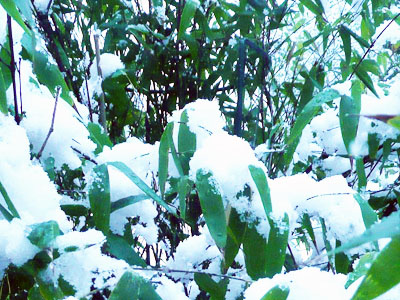Bamboo Maintenance and Upkeep
How to Grow Bamboo - Article Contents
Care and Maintence of Bamboo
Bamboo is an aggressive plant and will require general maintenance task throughout the year. Its behaviors are different than many other garden plants. In this section, we break down the common maintenance tasks you may encounter. Following this guidelines will help you maintain healthy and happy bamboo plants.

Impressive Phyllostachys vivax Bamboo.
Watering – Ornamental and garden bamboos require a regular watering schedule, and cannot rely completely on rain water. Bamboo likes to dry after watering, so your watering schedule will need to alternate days. It is important to keep a balanced water schedule, as too much or too little water can be harmful to the bamboo. Newly planted specimens should be watered at least twice a week in their ideal weather conditions. In areas with warm temperatures or frequent wind, the bamboo may require water up to 5 times a week. As a grower, you must make a judgment call on watering frequency by examining the leaves and soil. Bamboo leaves will start to curl inwards if they are not receiving enough water. This is a natural mechanism used by the plant to protect itself against drought. By curling the leaves the plant will prevent water from escaping by trapping it in the pockets it creates. If you notice that your bamboo is starting to display this behavior, it should be a red flag that more water is needed. Soil also needs to be monitored on a regular basis, with this being especially true for container bamboos. Bamboo growing in a container is vulnerable to overwatering, and it is common for gardeners to unknowingly waterlog the plant. This can lead to rotting of the rhizomes and roots, and can even kill the entire plant.
Fertilizer – After your bamboo plant is established, it is recommended to fertilize regularly. An organic fertilizer that is high in nitrogen is the ideal choice. Half rotted horse or cow manure is also an excellent choice, and can often be obtained for free. A standard high nitrogen lawn fertilized works well, and is often the most cost effective choice. Fertilizer should be applied once in the summer when rhizomes are developing, and again in the fall or early spring. Apply a 2 inch layer of your fertilizer mixture or compost around the base of the plant. You can also spread the mixture out to areas you want the plants to grow.
Thinning and Pruning – Pruning bamboo on a regular basis is usually not necessary and is primarily done for aesthetics. Culms will generally live up to ten years, but can start to dry out and look unattractive later in life. Removing the older culms is an important maintenance task and will promote the health of the newly emerging culms. The older culms will compete for light and nutrients with the younger culms and allowing them to live will lessen the overall beauty of the entire clump or grove. This is done by cutting off the old culm at soil level. We recommend that old or dead culms are removed at least once per year from your garden. In the case of timber bamboos, you can promote large and rapid growth by removing the smaller culms in the grove. Removing small culms will allow for the space and nutrients required to produce giant timber bamboo. Thinning and pruning will do wonders for the health and appearance of the plants.
Controlling Spread – There are several method used to control the spread of running (leptomorph) bamboos. The most common tactic is to install a HDPE rhizome barrier around the growing area. Check out our article on installing a rhizome barrier for a full breakdown.
Depending on the area, installation of a rhizome barrier can be a difficult or impossible task. The most simple and cost effective method of controlling bamboo is to prune the rhizomes on a regular basis. Rhizome pruning is a seasonal task, normally done in late fall through spring. As new rhizomes emerge from the soil, a sharp garden spade can be used to sever the rhizomes as they travel beneath the ground. Start by marking out the desired perimeter to which the bamboo should be confined. Next, plunge the spade as deep as possible into the soil along this perimeter. This will cut the rhizomes in the area and limit their growth for the remainder of the season. This must be done at least once per year in order to work effectively.
Winter Protection – Bamboo is most vulnerable during the winter months. In cold, windy climates there are necessary steps to take to protect your bamboo. After the initial planting, the goal is to allow the plant enough time to establish a root system and become hardy enough to survive in freezing winds, temperatures, and frost. Freezing winds are a young bamboo plant’s worst enemy. The cold temperatures are not particularly damaging, but the loss of moisture will cause plant to dry out quickly. For a young plant that is not well established, the aftermath of winter can be devastating. Frost can also be troublesome to bamboo. A consistent layer of frost has the potential to cause cell irreversible cell damage to the leaves, branches, and culms. Leaves are the most susceptible to frost, but the culms are also at risk during the winter. It is important to know and understand the cold hardiness of the variety of bamboo you are growing. This will help you prepare the area according to the exact needs of your bamboo.

Black Bamboo covered in snow. (Photo: Paul Smith)
The first and most important step to protecting your bamboo in the winter is to provide a heavy layer of mulch at the base of the plant. This will give the soil beneath some degree of protection from freezing temperatures and allow the roots and rhizomes to remain healthy. A good mulch can consist of dried leaves, organic compost, or a low growing groundcover plant. The next step is to protect the plant from excessive wind exposure. This can be done by planting some type of cold hardy plant in the vicinity of the bamboo to deflect and absorb the incoming wind. It is also possible to install a screen or panel in front of the plant to provide an equal level of protection.
